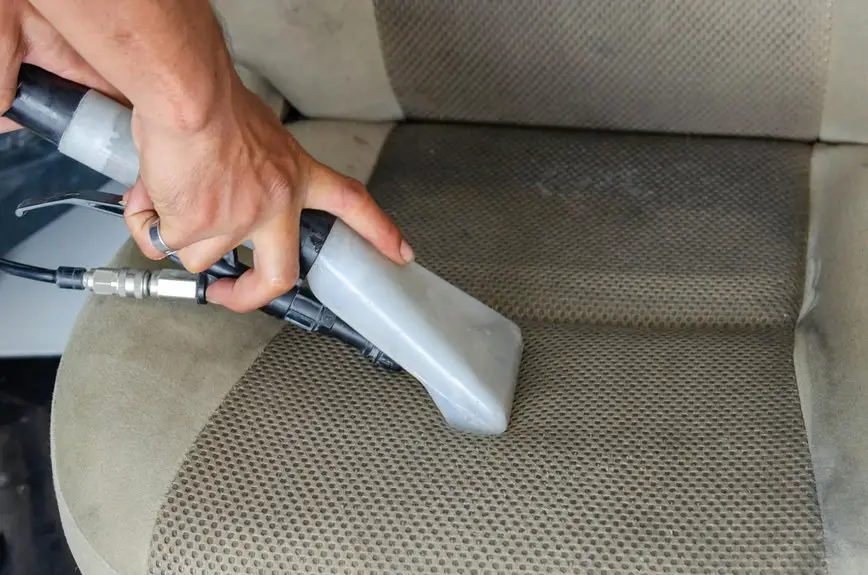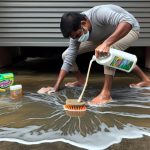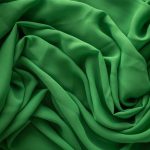To tackle upholstery stains effectively, first identify your fabric type using labels or texture tests. Gather gentle cleaners like mild detergent, white vinegar, and soft brushes. Act fast by blotting spills without rubbing, then apply appropriate stain removers—dish soap for water-based stains or baking soda for oils. Natural remedies like vinegar and hydrogen peroxide work well on tough spots. You can also prevent stains by vacuuming often and using fabric protectors. Keep going for detailed tips and techniques to keep your upholstery spotless longer.
Table of Contents
Key Takeaways
- Identify your upholstery fabric type to choose safe and effective stain removal methods.
- Blot fresh stains immediately with a clean cloth to prevent spreading or setting.
- Use mild detergent or specialized upholstery cleaners, testing on hidden spots first.
- Apply natural remedies like baking soda and vinegar for gentle, chemical-free stain removal.
- Prevent future stains by using slipcovers, vacuuming regularly, and applying fabric protector sprays.
Identifying Your Upholstery Fabric Type
How can you effectively remove stains without knowing your upholstery fabric type? You can’t, really. Different fabrics react uniquely to cleaning methods, so identifying your upholstery is essential.
Start by checking the manufacturer’s label, usually hidden under cushions or seams, which often specifies the fabric type and cleaning codes. If there’s no label, you can perform a simple test: dampen a cotton swab with water and dab an inconspicuous area. If it darkens quickly, the fabric might be water-sensitive.
Next, feel the texture—natural fibers like cotton or linen tend to be softer, while synthetics like polyester feel smoother or silkier. Knowing your fabric helps you choose the right stain remover and prevents damage, making your cleaning efforts effective and safe.
Essential Tools and Cleaning Supplies for Stain Removal
You’ll want to gather a few must-have cleaning products like mild detergent, upholstery cleaner, and stain remover sprays before you start.
Essential tools such as soft brushes, clean cloths, and a vacuum will help you tackle stains effectively.
Having these supplies ready makes the stain removal process much smoother and more efficient.
Must-Have Cleaning Products
Every home should stock a few essential cleaning products to tackle upholstery stains quickly and effectively.
When you have the right supplies on hand, you can save your favorite furniture from permanent damage and keep your living space fresh.
Here are the top three must-have cleaning products:
- Upholstery cleaner: Choose a gentle, fabric-safe formula designed specifically for your upholstery type to remove stains without harsh chemicals.
- White vinegar: A natural disinfectant and deodorizer that helps break down stubborn stains and neutralizes odors.
- Baking soda: Perfect for absorbing moisture and lifting dirt, plus it freshens fabric without leaving residue.
With these essentials ready, you’ll feel confident handling any spill or stain that comes your way.
Essential Removal Tools
Three essential tools make stain removal from upholstery much easier and more effective.
First, a soft-bristled brush helps you gently loosen dirt and debris without damaging fabric fibers.
Second, clean white cloths or microfiber towels are vital—they absorb stains and prevent color transfer. Avoid colored towels since they might bleed onto your upholstery.
Third, a spray bottle allows you to apply cleaning solutions evenly and control the amount of moisture you use, preventing over-saturation.
Having a small vacuum with upholstery attachments also comes in handy to remove loosened particles after treatment.
With these tools on hand, you can tackle stains promptly and efficiently, protecting your furniture and keeping it looking fresh and clean.
Always test tools on a hidden area first to avoid unwanted damage.
Step-by-Step Methods for Removing Common Stains
Before you start cleaning, you need to identify the type of stain you’re dealing with.
Different stains require specific techniques to remove them effectively.
Let’s walk through step-by-step methods tailored to common stains so you can tackle them with confidence.
Identifying Stain Types
How can you effectively tackle stains if you don’t first identify what caused them?
Recognizing the stain type is essential because each demands a unique approach. Start by observing the stain’s color, texture, and location.
Here’s a quick way to categorize common stains:
- Organic Stains: Think coffee, wine, or food. They often have a distinct color and can be sticky or oily.
- Inorganic Stains: These include dirt, mud, or rust. They usually have earth tones and can feel gritty.
- Protein-Based Stains: Blood, sweat, or dairy fall into this group. Notice if the stain is dark, and sometimes slightly crusty.
Effective Cleaning Techniques
To remove stains effectively, you need a clear, step-by-step approach tailored to the stain type.
First, blot fresh spills immediately with a clean cloth—never rub, as that spreads the stain.
For water-based stains like coffee or juice, mix a few drops of mild dish soap with warm water. Dampen a cloth with the solution and gently blot the stain from outside in.
For oily stains, sprinkle baking soda to absorb excess oil, let it sit for 15 minutes, then vacuum.
For tougher stains like ink or wine, use a specialized upholstery cleaner, following the product’s instructions carefully. Always test any cleaner on a hidden spot first.
Finally, let your upholstery air dry completely to prevent mold or discoloration.
Natural and Homemade Remedies for Upholstery Stains
Although commercial cleaners can be effective, you might find natural and homemade remedies gentler on your upholstery and safer for your family.
These solutions use simple ingredients you likely already have, reducing harsh chemicals’ risks. Here are three easy remedies to try:
- Baking Soda and Vinegar: Sprinkle baking soda on the stain, spray with vinegar, let fizz for 10 minutes, then blot with a clean cloth.
- Dish Soap and Warm Water: Mix a few drops of dish soap with warm water, apply gently with a sponge, and blot dry.
- Hydrogen Peroxide: Use a 3% solution on tougher stains, testing first on a hidden area to avoid discoloration.
These methods can restore your upholstery’s beauty without compromising safety.
Tips for Preventing Future Upholstery Stains
Since prevention saves you time and effort, adopting a few simple habits can keep your upholstery looking fresh and stain-free.
Start by setting clear rules, like no eating or drinking on your sofa, to reduce spills. Use washable slipcovers or throws in high-traffic areas to protect the fabric.
Regularly vacuum your upholstery to remove dust and dirt that can cause stains over time. Treat stains immediately—blot spills with a clean cloth instead of rubbing.
Consider applying a fabric protector spray to create a barrier against liquids and dirt. Finally, keep pets off furniture or groom them frequently to minimize hair and oils.
When to Call a Professional Cleaner
Even if you follow all the prevention tips, some stains can be stubborn or too extensive to handle on your own.
Knowing when to call a professional cleaner can save your upholstery from permanent damage. Here are three signs you shouldn’t ignore:
- Widespread Stains: When spills cover a large area, DIY methods might spread the stain or damage the fabric.
- Delicate Fabrics: Materials like silk or velvet require expert care to avoid discoloration or weakening.
- Lingering Odors: Persistent smells after cleaning attempts often need professional-grade treatments to eliminate.
If you face any of these, don’t hesitate to get professional help.
It’s better to act quickly and preserve your furniture’s look and longevity than risk costly repairs later.
Frequently Asked Questions
Can Upholstery Stain Removers Damage Pet Fur?
Yes, some upholstery stain removers can damage pet fur if they contain harsh chemicals. You should avoid applying these products directly on your pet and always rinse thoroughly if contact occurs to prevent irritation or damage.
How Do Humidity Levels Affect Upholstery Stain Removal?
Humidity’s like a sneaky fog; it makes stains stubborn by slowing drying and spreading moisture. You’ll want to work quickly in high humidity or use a fan to help stains lift and dry faster on your upholstery.
Are There Eco-Friendly Upholstery Cleaning Machines Available?
You can find eco-friendly upholstery cleaning machines that use less water and biodegradable detergents. These machines reduce chemical use and energy consumption, helping you clean effectively while minimizing your environmental impact.
What Are the Best Storage Practices for Cleaning Supplies?
Keep your cleaning supplies organized, keep them dry, and keep them out of reach. You’ll guarantee safety, maintain effectiveness, and extend their lifespan by storing them in a cool, well-ventilated, and secure place.
How Often Should Upholstery Be Professionally Cleaned?
You should have your upholstery professionally cleaned every 12 to 24 months. If you have pets, kids, or allergies, consider cleaning more often to keep fabrics fresh and extend their lifespan.
- How to Get Urine Smell Out of a Leather Sofa (Cat & Dog) - July 9, 2025
- How to Clean Mold and Mildew Off a Leather Sofa Safely - July 9, 2025
- How to Get Super Glue or Chewing Gum Off Your Leather Sofa - July 9, 2025







